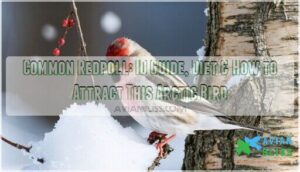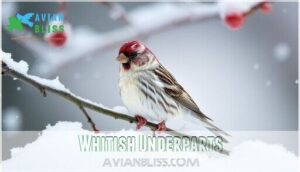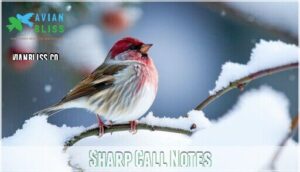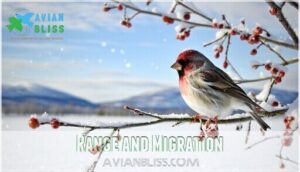This site is supported by our readers. We may earn a commission, at no cost to you, if you purchase through links.

These nomadic birds breed in tundra shrublands but venture south during winter, seeking birch and alder seeds. You can attract them with nyjer and sunflower seeds at specialized finch feeders.
Their remarkable cold tolerance lets them survive –65°F temperatures, making them true winter warriors of the bird world.
Table Of Contents
- Key Takeaways
- Common Redpoll Identification
- Habitat and Distribution
- Diet and Feeding Behavior
- Unique Adaptations and Behaviors
- Attracting and Supporting Redpolls
- Frequently Asked Questions (FAQs)
- Where can I find Common Redpoll?
- What is the difference between a Common Redpoll and a house finch?
- What bird feeder does a Common Redpoll eat?
- What is a Common Redpoll in Minnesota?
- How long do common redpolls typically live?
- Do common redpolls migrate in specific formation patterns?
- Can common redpolls learn to mimic human speech?
- What predators pose the greatest threat to redpolls?
- How do redpolls communicate with each other?
- When is the best breeding season timing?
- Conclusion
Key Takeaways
- You’ll identify common redpolls by their bright red forehead patch and black chin – males show pink breast coloring during breeding season, while females have streaked whitish underparts and conical bills for seed cracking.
- You can attract these Arctic finches with nyjer and black oil sunflower seeds in tube feeders – they’re nomadic visitors that travel thousands of miles south during winter when northern seed crops fail.
- You’re witnessing remarkable cold adaptation when you see redpolls – they survive temperatures down to -65°F through specialized throat pouches for seed storage and can eat up to 42% of their body weight daily.
- You’ll find them in brushy fields, woodland edges, and near feeders during irregular winter irruptions – they prefer birch, alder, and willow seeds but readily accept feeder offerings when available.
Common Redpoll Identification
You’ll recognize Common Redpolls by their distinctive red forehead patch, black chin, and streaky brown upperparts that create a characteristic field identification pattern.
Males display variable pink washing across the breast during breeding season, while females exhibit more subdued coloration with whitish underparts marked by fine dark streaking.
Distinctive Features
You’ll recognize a Common Redpoll by several key field marks that make identification straightforward. These Arctic finches display distinctive characteristics that set them apart from other small songbirds.
- Red forehead – bright crimson patch above the bill
- Black chin – small dark bib beneath the beak
- Conical beak shape – pointed yellow bill for seed extraction
- Notched tail feathers – square-tipped with distinctive pattern
Listen for their twittering trill and soft rattle calls during wing movement through trees.
Male and Female Plumage
Adult males display striking sex differences in their plumage patterns during breeding season. You’ll notice males feature a distinctive red forehead and vibrant pink wash across the chest, while females show duller coloration without the rosy breast tones.
Both sexes maintain the characteristic black chin patch. Color variations intensify through molt cycles, with males developing richer feather texture and more pronounced Acanthis flammea markings compared to their female counterparts.
Streaky Brown Upperparts
Beyond the bright forehead and pink chest, you’ll notice Common Redpoll’s streaky brown upperparts create distinctive feather patterns. These brown coloration markings cover the back and shoulders, with subtle wing bars visible during flight.
The streaked appearance helps with bird identification, distinguishing Acanthis flammea from similar species. Their beak shape remains conical and yellow, while tail feathers show the characteristic notched profile that aids redpoll bird identification.
Whitish Underparts
The Common Redpoll’s underparts display variable whitish coloration with distinctive streaking patterns. You’ll notice females and juveniles exhibit heavier streaking across their breast and flanks compared to adult males.
This Feather Coloration creates important identification markers for Bird Identification purposes. The whitish base color contrasts sharply with the streaky brown upperparts, helping distinguish Common Redpolls from similar finch species during field observations.
Sharp Call Notes
Musical Acoustic Signals help you identify Redpoll through their distinctive Vocalisation Patterns. These energetic finches produce three primary Sound Waves: electric zapping chatter notes, nasal rising whistles lasting half a second, and rattling trills.
Their Call Frequency increases during foraging, creating constant communication within flocks. These Bird Songs serve as identification markers when spotting Common Redpoll in winter feeding areas.
Habitat and Distribution
You’ll find Common Redpolls breeding across Arctic and sub-Arctic regions in tundra habitats with scattered shrubs, birch, willow, and alder stands.
During winter months, these nomadic finches move south into semi-open country including woodland edges, brushy fields, and areas near bird feeders where they can access abundant seed sources.
Breeding Habitats
Finding breeding Common Redpolls means exploring Arctic Tundras and Subarctic Regions where these resilient finches establish their Nesting Habits. You’ll discover them in Shrub Landscapes dominated by birch, willow, and alder thickets, plus Forest Edges near coniferous stands. They avoid tree cavities, preferring low shrub forks. Wetland Habitats with scattered vegetation also attract breeding pairs.
Habitat Conservation efforts protect these specialized northern environments. To support these birds, providing the right bird seed options is essential for their survival.
Winter Movements
Wanderlust drives these Arctic finches southward during harsh winters when northern seed crops fail. Common Redpoll flocks exhibit nomadic Winter Migration patterns, traveling thousands of kilometers in search of birch and alder seeds. Their notable Cold Adaptations enable survival at -54°C through doubled plumage weight and specialized Seed Storage pouches.
Winter Finches like redpolls demonstrate exceptional Flock Behavior, forming groups numbering in the thousands while maintaining non-territorial Arctic Survival strategies during their southward journeys. The ability of redpolls to survive harsh winters is largely due to their unique seed storage methods that allow them to conserve energy.
Range and Migration
You’ll find Common Redpolls across circumpolar Arctic regions, with breeding areas spanning Alaska, northern Canada, Greenland, and northern Eurasia. These Arctic birds follow irregular migration patterns, moving south along major flyway routes when food becomes scarce in their northern habitats.
Winter migration can bring flocks as far south as the northern United States, though timing varies dramatically based on seed crop availability in their traditional wintering grounds. To attract these birds, using the right bird seed feeders is essential for their survival.
Diet and Feeding Behavior
You’ll discover that Common Redpolls exhibit specialized foraging adaptations that enable survival in Arctic environments, utilizing their unique esophageal pouches to store seeds temporarily before retreating to sheltered locations.
These small finches demonstrate notable dietary flexibility, consuming primarily birch and alder seeds while supplementing their nutrition with catkins, buds, and seasonal insects during breeding periods.
Primary Diet
Common Redpoll seed preferences center on small, energy-dense options that meet their substantial caloric needs. These Arctic finches primarily consume birch, alder, and willow seeds, with nyjer seeds and sunflower seeds becoming winter staples at feeders.
Their specialized food storage pouches enable efficient nutrient intake during harsh conditions, allowing extended winter foraging sessions. Understanding the importance of proper bird feeding habits is vital for attracting and supporting Common Redpolls in your area.
Summer Diet
During breeding season, you’ll notice Common Redpolls expand their seed selection to include protein-rich insects. Summer foraging behavior shifts as these Arctic birds supplement their typical diet with caterpillars, aphids, and small flies. This insect consumption provides essential nutrients for reproduction and chick development.
While nyjer seeds and sunflower seed remain staples, increased fruit eating from berries enhances their higher summer nutrient intake requirements.
Feeding Behavior
Redpolls exhibit notable foraging strategies that reflect their arctic origins. You’ll observe these finches employing adaptive eating behaviors, utilizing specialized seed storage capabilities through throat pouches for winter feeding.
They demonstrate complex food caching techniques, moving in flocks across birch and alder stands.
Their common redpoll diet preferences make finch feeders particularly attractive when stocked with millet seeds and appropriate bird seed preferences.
Throat Pouches and Seed Storage
You’ll discover that redpolls possess a notable esophageal diverticulum—a specialized throat pouch for seed storage. This adaptive eating mechanism allows winter survival through efficient food caching strategies:
- Rapid Collection: Redpolls quickly gather millet seeds and other small seeds in exposed feeding areas
- Temporary Storage: The esophagus holds up to 2 grams of seeds for several hours
- Safe Retreat: Birds relocate to sheltered locations away from predators and wind
- Controlled Digestion: Seeds are regurgitated, processed, and consumed at ideal timing
- Energy Conservation: This bird seed preferences system maximizes caloric intake while minimizing exposure
This throat pouch adaptation distinguishes Common Redpoll diet patterns from other finches, supporting their exceptional cold tolerance.
The Common Redpoll’s ability to survive harsh winters is also influenced by their Arctic breeding habits, which play a vital role in their overall survival strategy.
Favorite Food
Small birch catkins and alder seeds top the redpoll’s menu, providing essential winter calories. These finches show strong seed preferences, targeting nutrient-dense options like nyjer and sunflower seeds at feeders.
Their caloric needs drive efficient winter foraging patterns, with food storage capabilities supporting extended feeding sessions. Understanding these nutrient sources helps attract winter finches and goldfinches through strategic finch feeder placement and bird behavior observations.
Unique Adaptations and Behaviors
You’ll observe that Common Redpolls possess notable physiological adaptations that enable survival in extreme Arctic conditions, including specialized esophageal pouches for seed storage and enhanced metabolic processes for cold tolerance.
These Acanthis flammea demonstrate outstanding behavioral flexibility through their nomadic movement patterns and capacity to consume up to 42% of their body weight in seeds daily during harsh winter conditions.
Cold Tolerance
What sets these Arctic specialists apart isn’t just their diet—it’s their exceptional Cold Adaptation abilities. Redpolls demonstrate unparalleled Frost Resistance, surviving temperatures down to –65°F through sophisticated Thermal Regulation.
Arctic finches master extreme cold through doubled winter plumage and specialized thermal regulation down to -65°F
Their winter plumage increases by 31%, creating enhanced insulation. These masters of Arctic Acclimation use controlled hypothermia and snow tunneling for Winter Survival, showcasing outstanding Endurance that defines true Arctic Bird Migration specialists.
High Seed Consumption
During winter foraging periods, these arctic finches consume exceptional quantities of seeds daily, sometimes eating up to 42% of their body weight. This notable seed consumption pattern represents a critical cold adaptation strategy.
Their specialized feeding strategies include rapid seed processing and selective seed preferences for high-energy birch and alder varieties. Such adaptability ensures survival during harsh northern winters when seed storage becomes essential for sustained energy.
Long-Distance Travel
Redpolls’ nomadic lifestyle showcases outstanding endurance as they navigate thousands of miles during winter invasion events. These Arctic breeding specialists demonstrate extraordinary flight routes, following unpredictable migration patterns based on food availability rather than traditional seasonal schedules.
- Irruptive Migration: Unlike predictable seasonal migrants, redpolls exhibit irregular winter invasion movements spanning 1,000+ miles
- Flight Routes: Follow boreal forest corridors southward, often reaching northern United States during food shortages
- Endurance Factors: Cold adaptation mechanisms enable sustained long-distance flight in harsh winter conditions
- Navigation Strength: Flocks demonstrate notable agility in locating scattered food sources across vast territories
Active Foragers
These Arctic finches’ foraging strategies showcase notable adaptability and agility during seed gathering expeditions. You’ll observe their endurance as flocks demonstrate coordinated flocking behavior, systematically working through birch catkins and alder buds.
Their winter adaptation includes specialized food storage capabilities, allowing efficient energy management. Redpoll strength allows accessing seeds from challenging locations while maintaining constant movement throughout harsh conditions.
The birds’ ability to survive is linked to their unique beak adaptations, which play a vital role in their foraging success.
Attracting and Supporting Redpolls
You can attract these Arctic finches to your feeding station by offering high-energy seeds that match their natural dietary preferences, particularly thistle (nyjer) and black oil sunflower seeds in tube or sock feeders.
Maintaining clean feeders and providing a habitat with native seed-producing plants like birch, alder, and weedy areas will create ideal conditions for supporting redpoll populations during their unpredictable winter irruptions.
Providing Thistle or Nyjer Seeds
Your best bet for attracting redpolls involves stocking specialized finch feeders with fresh nyjer seeds. These tiny black seeds match perfectly with redpoll bill size and provide essential high-fat nutrition during harsh winters.
Tube feeders with small ports or mesh sock feeders work exceptionally well for finch species like the rostrata/islandica subspecies group. Keep feeders consistently filled throughout winter months to support these fascinating Arctic visitors in your backyard bird watching adventures.
Offering Black Oil Sunflower Seeds
Black oil sunflower seeds rank among the top choices for attracting Common Redpolls to your backyard feeding stations. These nutrient-dense seeds provide essential fats and proteins that aid Redpoll energy requirements during harsh northern winters.
- Seed Preferences: Redpolls crack hulls easily with their conical bills, accessing high-fat kernels efficiently
- Feeder Designs: Use tube feeders with multiple perches to accommodate flocking behavior of Finch Species
- Sunflower Benefits: Higher oil content than striped varieties aids cold-weather metabolism for Bird Attraction
- Seed Storage: Keep seeds dry in sealed containers to maintain freshness for ideal Backyard Bird Watching
By offering sunflower seeds, you can create a reliable food source option that attracts a variety of bird species to your yard.
Feeder Maintenance
Clean feeders become magnets for winter finch flocks seeking quality nutrition. Regular feeder cleaning prevents harmful bacteria and mold that compromise seed quality, ensuring redpolls stay healthy during harsh conditions.
Position your finch feeder in sheltered spots near natural roost sites like dense shrubs. Winter preparation includes checking feeder placement for easy access and maintaining fresh seed supplies to support these hardy Arctic visitors.
Welcoming Habitat
While creating Bird Friendly environments, focus on native shrubs and trees that produce seeds year-round for Redpoll habitat creation. Plant birches, alders, and willows to support Wildlife Conservation through Eco Gardening practices.
Maintain dense vegetation for roost sites where these finches can shelter their feathers from harsh weather.
Your Yard Planning should include natural seed sources alongside Finch Feeder Attraction strategies, though birdhouses aren’t necessary for these ground-nesting species.
Frequently Asked Questions (FAQs)
Where can I find Common Redpoll?
During irruptive winters, millions of redpolls venture south from Arctic regions. You’ll spot these hardy finches in brushy fields, woodland edges, and weedy areas across northern states and southern Canada when food becomes scarce in their tundra breeding grounds.
What is the difference between a Common Redpoll and a house finch?
You’ll notice Common Redpolls are smaller than House Finches, with distinctive red foreheads and black chins. House Finches lack these features, showing brown-streaked plumage instead.
What bird feeder does a Common Redpoll eat?
You’ll want to set up tube feeders filled with nyjer (thistle) seeds or sunflower seeds.
These finches particularly love thistle seed feeders and also readily accept black oil sunflower seeds at winter feeders.
What is a Common Redpoll in Minnesota?
You’ll spot this Arctic wanderer as a tiny red-capped visitor during Minnesota’s harsh winters. The Common Redpoll (Acanthis flammea) measures just 5-5 inches, displaying diagnostic crimson forehead patches and notched tail feathers while foraging in flocks.
How long do common redpolls typically live?
You’ll find that most individuals in the wild live around 2-3 years, though the oldest known individual reached at least 7 years, 10 months old. Their lifespan‘s quite short for songbirds.
Do common redpolls migrate in specific formation patterns?
You’ll observe these birds traveling in loose, undulating flocks rather than rigid formations. They don’t follow structured patterns like geese or other waterfowl.
Instead, they prefer a freestyle, erratic approach that resembles an aerial dance party.
Can common redpolls learn to mimic human speech?
You can’t teach these finches to mimic human speech. Vocal production learning is rare in the animal kingdom and only found in a handful of mammalian taxa and three bird groups.
Redpolls aren’t vocal learners like parrots.
What predators pose the greatest threat to redpolls?
Raptors dominate threats you’ll encounter – Merlins, Sharp-shinned Hawks, and various owls strike from above.
Ground predators like domestic cats, foxes, and weasels target vulnerable birds and nesting areas consistently throughout seasons.
How do redpolls communicate with each other?
You’ll hear their energetic "chich-chich-chich" flight calls and sharp zapping notes as they travel in chattering flocks.
Redpolls use three main vocalizations: sharp chattering, nasal rising whistles, and rolling trills lasting nearly a second.
When is the best breeding season timing?
Like nature’s clock striking spring, you’ll find breeding season runs from late April through August. Clutch timing depends on local weather conditions, ranging from late April to early June for first broods.
Peak activity occurs during ideal resource availability.
Conclusion
Picture flocks of common redpolls descending on your winter feeders like tiny Arctic ambassadors, their crimson caps glowing against snow-covered branches. These notable finches demonstrate nature’s ingenuity through specialized adaptations that enable survival in extreme cold conditions.
By providing nyjer seeds and maintaining clean feeders, you’ll create an inviting environment for these nomadic visitors. Understanding their identification features, dietary preferences, and behavioral patterns enhances your birdwatching experience while supporting these resilient Arctic species during their southern wanderings.














